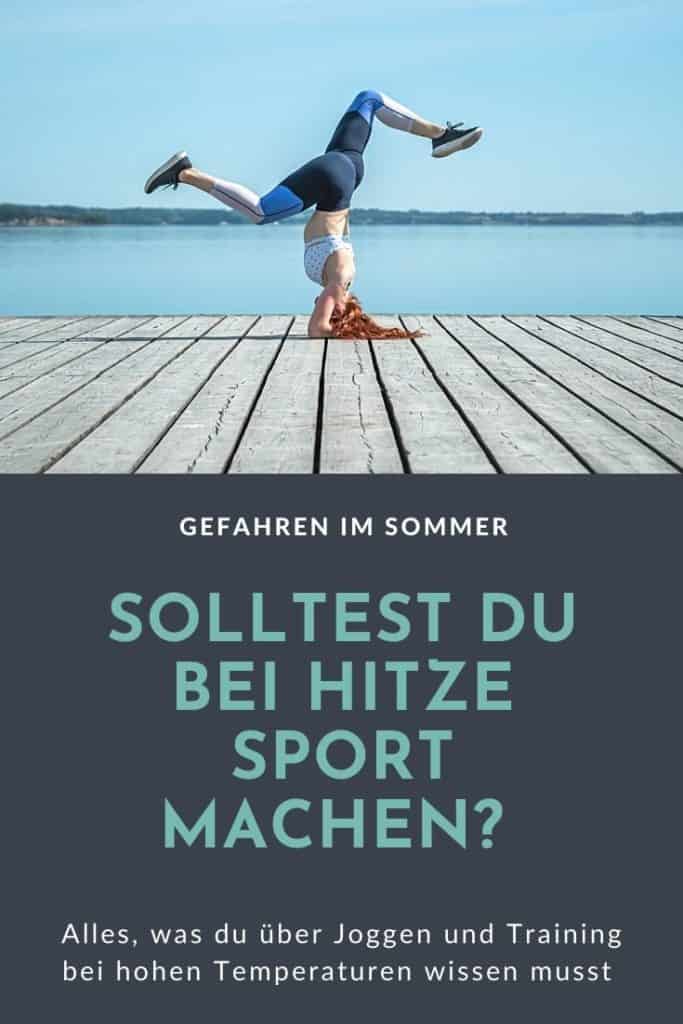What special features actually apply to sports in the heat? Summer is here and is hanging with Europe with relentless temperatures. It is not uncommon for the thermometer to exceed 30°C and the sun is shining brightly. In this article you will find out how to stay fit in summer and what you need to consider if you want to jog or train in high temperatures.
Awaiting you:

What makes exercise in the heat so strenuous and stressful for your body?
If you’ve ever jogged or done high-intensity interval training in hot temperatures, you know that exercise in the heat can feel incredibly strenuous.
But why is that so?
In the heat, your body has to work hard. To cool you down in high temperatures, blood flow to your skin increases. This allows you to secrete sweat, which then evaporates and keeps your body temperature at a constant 37°C.
But this also means that you become dehydrated more easily. Even a slight lack of water of a few percent can reduce your performance and increase the strain on your heart.
In addition, increased blood flow to the skin means that blood becomes scarcer elsewhere. This means there is less blood available to your muscles and organs.
Both dehydration and the altered distribution of blood in your body mean that your heart has to beat faster and more intensely to achieve the same level of performance.
Can I jog or exercise in high temperatures?
Although training and jogging in high temperatures is generally more stressful and strenuous than in the cooler months, it is not necessary for healthy people to take a break for the entire summer.
On the contrary: if you take a break for three months or longer, you will lose valuable fitness and have a much harder time training after a long break. This increases your risk of injury and the chance of overuse symptoms such as Achilles tendon problems, shin pain, back pain when jogging and more.
A good level of training can even be helpful in dealing better with temperature changes and becoming more resilient to such external stresses.
When it comes to exercising in the heat, it’s not about giving up completely, but rather finding a sensible way to deal with it and making adjustments.
Temperatures below 25°C are harmless for most healthy athletes. At temperatures above 30°C, high loads and competitions should always be carefully considered, as the risk of heat injuries increases significantly.


Red Flags – warning signs and dangers for sport in the heat
Especially at the beginning of the hot season, the risks and dangers of exercising in the heat are highest. Direct sunlight and the loss of fluids and electrolytes pose the greatest dangers. Because this can cause burns, heat exhaustion, heat cramps and even a heatstroke come.
Most of these phenomena come on gradually. That’s why it’s particularly important to pay attention to yourself and take the smallest changes seriously.
Red flags – these are the warning signals for heat stroke, heat exhaustion and co.
- Muscle cramps
- Stiff neck
- Headache
- Stomach or intestinal cramps
- increased body temperature >37°C
- Decrease in performance
- very heavy sweating
- Feeling of exhaustion and tiredness
- weakness
- dizziness
- general unrest
- very high pulse
If you notice any of these symptoms, you should stop exercising immediately. Get out of the sun immediately and help your body cool down. It is best to lie down with your legs elevated and your head slightly elevated. Use cold compresses on the neck, head, forehead and extremities. Make sure you drink enough fluids. Water with some electrolytes is best suited for this. Fruit juice or milk can also support hydration.
Exercise in the heat – these drinks are best
But which drinks can best prevent dehydration? In one Hydration index study from the American Journal of Clinical Nutrition, 13 different drinks and their effect on the human body’s fluid balance were examined. The result may seem surprising to some people. In this study, the front runner for effective hydration after exercise was skimmed milk. This is closely followed by full-fat milk and special hydration solutions. Coffee and beer are the least suitable.


The best tips for exercising in the heat
Do you want to go jogging or do other sports in the heat despite the high temperatures? Then here you will find the best tips for the right behavior to get through the summer safely and healthily.
Give your body time to adapt to exercise in the heat
At the beginning of a heat wave, the temperatures put the greatest strain on your body. That’s why we do ourselves a big favor by starting slowly and giving the body time to adapt.
This means that in the first hot days of summer you should reduce the intensity and duration of your training sessions and give yourself up to two weeks to gradually get used to the high temperatures.
Pay attention to possible warning signs
Throughout the adjustment period and beyond, it is absolutely necessary that you be mindful and careful with your own body. Keep an eye on possible warning signs and stop your training immediately if any of the red flags occur.
If your exercise feels unusually strenuous or you are very exhausted after training, it means that your workout was too intense. Then stop the training and adjust it next time.
Not just when exercising in the heat: measure your pulse
Pulse measurement is a great tool for objectively assessing the strain of your training sessions, and not just in hot weather. The pulse beats per minute compared to your maximum heart rate provide information about how stressful a training session is.
By training with pulse, you can regulate the intensity at any time and adjust it if it gets too intense. Especially at high temperatures, it’s easy to underestimate the stress and, for example, jog too fast. Pulse measurement allows us to react immediately.
Your heart does hard work when it’s warm. It must beat up to twenty more beats per minute than at lower temperatures.
If the load remains the same, an increase of five strokes approximately every 15 minutes is normal in the heat.
So when jogging in high temperatures, focus on your heart rate rather than your speed. This way you can be sure not to overload your heart.
Overall, adjust the intensity by integrating breaks, walking in between, and avoiding high-intensity interval training.


The right timing
The right time of day for your training in summer is early in the morning or late in the evening. The lowest daily temperatures are usually between 4:00 a.m. and 8:00 a.m. In the evening it usually starts to cool down again after 7 p.m.
If possible, avoid the midday heat between 11 a.m. and 4 p.m.
Think about sun protection
Sun protection is an absolute must-have for the hot summer months. Even if you train in the shade, you shouldn’t miss out on various types of sun protection. This includes:
- Waterproof sunscreen with SPF 50+
- Special facial sunscreen (does not burn your eyes)
- Headgear
- sunglasses
- Functional clothing
Also, don’t forget to reapply sunscreen at least every two hours when you’re outside. This is the only way to guarantee UV protection.
Exercise in the heat – avoid the sun
Overall, you should avoid direct sun if possible. If you go jogging in high temperatures, prefer shady paths such as in the forest.
A well-ventilated or even air-conditioned room can sometimes be the best choice of environment for exercising in the heat.
The right nutrition
Even in hot weather, a balanced diet and adequate energy intake remain relevant. Many people have less appetite when it gets warmer. However, it is necessary that you take sufficient care of yourself. You can increase your micronutrient intake through fresh fruits, lots of vegetables and fruits and salads, smoothies and shakes made from them. Also consciously integrate protein sources and ensure an overall energy intake that corresponds to your activity level.
Drink enough fluids and pay attention to your electrolyte intake
When you exercise in the heat, you not only lose a lot of fluid, but also electrolytes. You can lose up to one and a half sweats per hour of physical activity. One liter of sweat contains approximately 50mg magnesium, 2g sodium, 70mg calcium and 480mg potassium. This loss of electrolytes and fluids must be compensated for.
In addition to water, special electrolyte powders or micronutrients are a good choice. A little salt in the water improves the absorption of the liquid.
Drink small sips regularly while exercising. As a rule of thumb, about 150ml every 10-15 minutes works. Drinking more at once offers no benefits as you will simply excrete more water.
